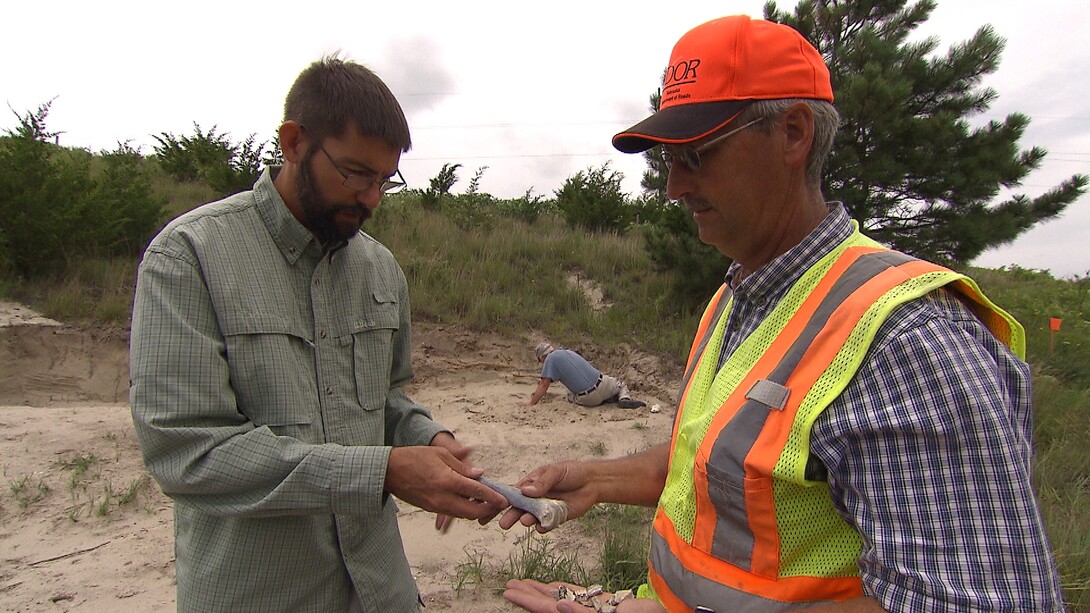
Kristina Jackson | University Communication and Marketing
Reprinted from Nebraska Today
The University of Nebraska State Museum’s Highway Paleontology program is uncovering history hiding beneath our feet and tires.
The Highway Paleontology program, a partnership between the State Museum and the Nebraska Department of Transportation, digs into the history of the state by bringing in paleontologists to comb road construction sites for fossils. Shane Tucker, highway paleontologist, said the work helps ensure these stories come to light.
“Nebraska is really rich in fossil resources, so any time the ground is disrupted there’s a chance fossils will get uncovered,” Tucker said.
The team reviews upcoming projects and determines if the site is one that is likely to hold fossils. They monitor active projects and sometimes receive calls from construction crews who uncover something during the course of their work.
“The ones that have more excavation on them will have a higher tendency to produce fossils because there’s more area that’s being disrupted, so we’ll monitor those more closely, especially in areas we know there’s previously known localities or the layers of rock we typically find fossils from,” Tucker said.
On a work site, the highway paleontology team will follow behind equipment or walk an existing roadcut looking for signs of fossils. If they spot something they want to explore further, they will ask the construction crews to shift where they are working.
They try to minimize interruptions to construction work, which helps foster the cooperation. Tucker said the relationship between the crews can sometimes take time to build because workers are concerned a construction project will be delayed, but when they see the process it grows into a fun partnership.
“They’re still working, and then they get interested,” he said. “They notice they’re going to be able to do their job while we do ours, and it’s pretty cool that we’re going to save these fossils, so they get excited about it as well.”
Tucker excavates an 8 million-year-old giant tortoise shell from the highway right-of-way in western Nebraska.
When the team does spot a fossil, they dig around it, encase it in a plaster “field jacket,” and bring it to the museum for further examination.
The program was officially established by legislation passed in 1959. However, the University of Nebraska State Museum has been working on excavations in road construction projects as far back as the 1930s.
One of Tucker’s personally more memorable finds was the skull of a sling-shot horned “deer” from a 20 million-year-old river deposit in western Nebraska. Another was a more than 3-foot long giant tortoise shell from 6 to 8 million years ago uncovered near Kimball.
Tucker has been involved with the program for around 25 years. As a kid, he and his family would go camping and fishing, and he would collect clamshells in the rocks on the shoreline. They would also visit natural history sites on trips, including Ashfall Fossil Beds, which opened to the public when he was in high school and where he eventually worked as an intern as an undergraduate at the University of Nebraska–Lincoln.
He said he’s long known he was interested in this field of study, finding things that might otherwise have remained hidden.
“It’s exciting to find something and be the person that discovered the specimen that’s been in the ground for thousands or millions of years,” he said.
Tucker enjoys reconstructing the history of the region, including what kind of plants, animals and landscapes were present. Fossils can contain indicators of what animals ate, where and how they moved, and what kind of environment they lived in, for example. For Tucker, the work is an important way to document the history of Nebraska’s animals, land, climate and more.
“Fossils are unique, and they’re irreplaceable and nonrenewable,” Tucker said. “These specimens document Earth’s history. They’re telling the stories of what it was like before humans were there to see them.”